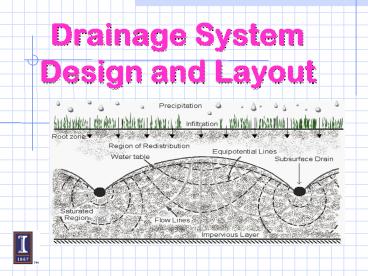Drainage System Design and Layout - PowerPoint PPT Presentation
Title:
Drainage System Design and Layout
Description:
Title: Workshop 1: Signal Conditioning Circuit Design Author: tdollin2 Last modified by: Richard Document presentation format: On-screen Show (4:3) – PowerPoint PPT presentation
Number of Views:3379
Avg rating:3.0/5.0
Title: Drainage System Design and Layout
1
Drainage System Design and Layout
2
Design Process Flowchart
Select DC, Spacing Depth
Background Information (Soils, Topo, Crops)
Determine Drain Sizes
Installation
Drainage Needed
Develop System Layout
NO
Confirm Outlet
Determine Grades Depth
NO
3
Design Process Flowchart
Select DC, Spacing Depth
Background Information (Soils, Topo, Crops)
Determine Drain Sizes
Installation
Drainage Needed
Develop System Layout
NO
Confirm Outlet
Determine Grades Depth
NO
4
Drainage Outlets
5
Design Curves
Outlet channels designed according to Curve B
will provide excellent agricultural drainage in
Illinois. Use this curve for drainage of truck
crops, nursery crops, and other specialty crops.
Designs based on curve B will provide the best
drainage that can normally be justified in
agricultural areas.
6
Design Curves
Channels that are designed according to curve C
will provide good agricultural drainage in
Illinois. This curve is the one most often
recommended for drainage of Illinois cropland
7
Drainage Outlets
Designs based on curve D provide satisfactory
agricultural drainage as long as frequent
overflow does not cause excessive damage. This
curve is generally recommended for pasture or
woodland. It may also be adequate for drainage of
general cropland in northern Illinois, provided
that the landowner carries out an excellent
maintenance program. Designs based on curve D
provide the minimum amount of drainage
recommended in Illinois.
8
Design Curves
Drainage CFS/ Acre In/Day
Curve 100
Acres (Drainage Coefficient) B
20 4.8 C
8 2.0 D
5 1.2
For comparison For a 100 acre watershed, RCN
75, Avg. Slope 1 in Central Illinois
A 2 Yr., 24 Hr. Rainfall
yields 1 of Runoff and would result in a Peak
Flow of 30 CFS.
A 10 Yr., 24 Hr. Rainfall
yields 2 of Runoff and would result in a Peak
Flow of 70 CFS.
9
Ditch Configuration
Once you know what the capacity of the outlet
channel must be, you need to determine the size
that will enable it to convey the desired amount
of flow without letting the water surface rise
above a predetermined elevation. The following
sections describe some basic hydraulic concepts
that will help you design a channel of the proper
size
.
10
Outlet Ditches
Velocity The velocity of water flow must be high
enough to prevent siltation in the channel but
low enough to avoid erosion. Listed on the next
page are the maximum velocities for drainage
areas of 640 acres or less. The velocity should
be no lower than 1.5 feet per second. A lower
velocity will cause siltation, which encourages
moss and weed growth and reduces the cross
section of the channel.
11
Hydraulic Gradeline
12
Channel Velocity
The most widely used equation for designing
outlet channels was developed by Robert Manning
in 1890 and is known as Manning's equation
where V average velocity of flow (ft/sec), n
coefficient of roughness, R hydraulic radius
(ft), s slope of hydraulic gradient (ft/ft).
13
Manning Routine
14
Design Process Flowchart
Select DC, Spacing Depth
Background Information (Soils, Topo, Crops)
Determine Drain Sizes
Installation
Drainage Needed
Develop System Layout
NO
Confirm Outlet
Determine Grades Depth
NO
15
Drainage Coefficient
16
Design Process Flowchart
Select DC, Spacing Depth
Background Information (Soils, Topo, Crops)
Determine Drain Sizes
Installation
Drainage Needed
Develop System Layout
NO
Confirm Outlet
Determine Grades Depth
NO
17
Drain Spacing Depth
- Design for uniform depth throughout system
- (depends on layout)
- Depth will of course vary on flat and rolling
topography
18
System Layout
19
System Layout
20
System Layout
21
Contour Map
22
System Layout
Cost Differential 50/acre
23
Design Process Flowchart
Select DC, Spacing Depth
Background Information (Soils, Topo, Crops)
Determine Drain Sizes
Installation
Drainage Needed
Develop System Layout
NO
Confirm Outlet
Determine Grades Depth
NO
24
Drain Sizing Tool
25
Result Display
26
Materials
27
Drainage Materials
28
Drainage Materials
29
Drainage Coeff.
30
Drainage Coefficient
31
Design Criteria
32
Tile Mathematics
10 3 x 6
12/2 8
33
Sedimentation Options
34
Design Chart
35
Can be Saved
36
Lateral Specification
37
Lateral Specification
38
(No Transcript)
39
Inlets
40
Questions?































